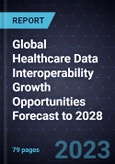Systems to Move Beyond Integration Toward Semantic Interoperability
This study will focus on the global healthcare data market, sharing insights about the opportunities available and highlighting new regulatory and technical capabilities that are driving growth. The report will analyze the main trends impacting the market, including the present state of data interoperability, the changing post-pandemic market requirements, growth drivers and barriers, and significant growth opportunities. In addition, the report will profile leading vendors and new entrants that are making headway in this space.
Interoperability refers to the ability to exchange data among different systems or applications and make use of the incoming data. In healthcare, this generally means the ability to share data between electronic health record (EHR) systems and other health IT applications, such as a clinical decision support system (CDSS), computerized physician order entry (CPOE) system, pharmacy management system (PMS), laboratory management system (LMS), and various other systems used in the healthcare space.
While the ultimate need is to develop semantic systems, interoperability is currently most efficiently achieved through application program interfaces (APIs). APIs can be defined to provide access to basic data sets all the way to complete program processes. These codes can be developed and provided by application vendors or developed by third parties. Meanwhile, to achieve semantic interoperability, there is increased emphasis on sharing data in a standard format. The Fast Healthcare Interoperability Resources (FHIR) standard has received new rules and promotion by the US government's Department of Health and Human Services. Developed by the Health Level 7 organization, FHIR provides a framework for data exchange that, while currently limited in its ability to handle unstructured data, still provides a foundation on which to build more robust data exchanges.
Interoperability is the need of the hour. As the data generated by different health IT applications grows exponentially, there is a need to make systems understand the data and provide actionable insights to end users. To achieve interoperability, major healthcare stakeholders acknowledge the need to invest in digital infrastructure capabilities that facilitate cross-continuum patient information exchange and support evidence-based care. Regulatory agencies are also embracing policies that advocate for major health IT vendors to become fully interoperable with one another. The objective is to drive a progressive digital healthcare approach, one that is standardized, collaborative, and multi-disciplinary yet modular and API-based. To achieve the desired future state and adhere to the policies/rules developed by the US Centers for Medicare and Medicaid Services (CMS) and Office of the National Coordinator for Health Information Technology (ONC), the healthcare ecosystem needs to overcome financial and technological challenges.
The market is driven by strong growth in the data integration and enterprise data exchange segments. The newer segment, the enterprise master patient index, is gradually gaining pace and will witness the fastest growth during the forecast period (2024-2028). Regionally, the United States and Europe will command the largest revenue share, with Asia-Pacific gradually catching up with Europe. Technology vendors and ICT companies support government and industry players to improve patient data accessibility globally.
Interoperability will lead to accessing data from wearables and establishing two-way communication with patients, orchestrated by digital front doors. Further, technological evolution, especially the use of dynamic AI (machine learning, natural language processing, conversational AI, and generative AI), will accelerate the process of data conversion between different standards and decipher meaning from the incoming data. Interoperability market growth will be driven by joint efforts among policy-makers and all decision-making stakeholders involved in technology development, procurement, and utilization.
Table of Contents
Companies Mentioned (Partial List)
A selection of companies mentioned in this report includes, but is not limited to:
- InterSystems
- Optum
- Oracle
- Salesforce








